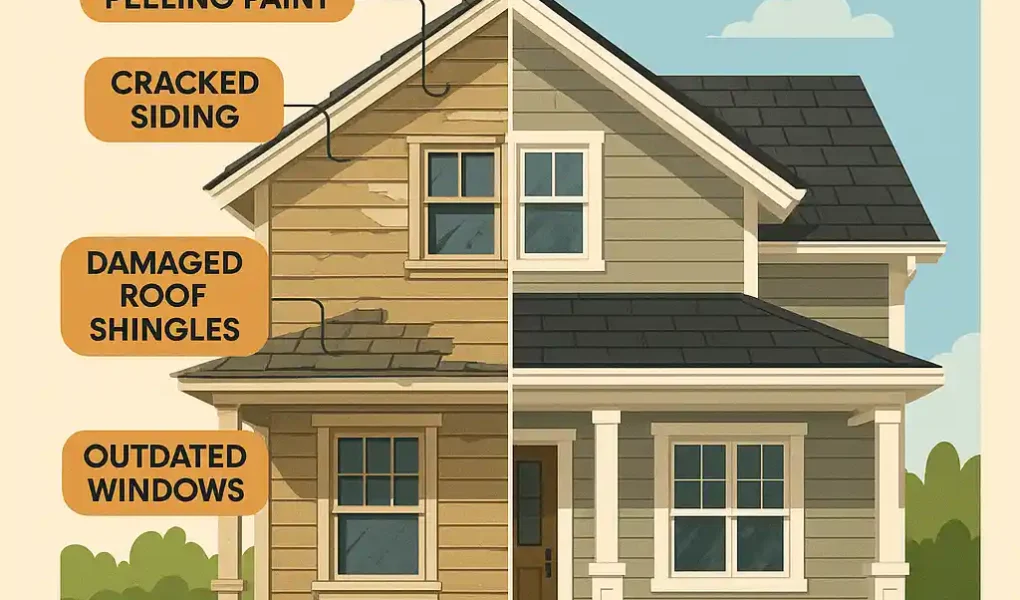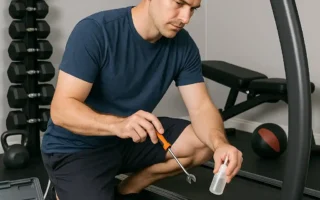Your home’s exterior protects everything inside. It shields you from wind, rain, sun, and pests — and it affects how your property looks to others. But over time, even the best materials wear down. When that happens, damage can start to spread beneath the surface without you noticing right away.
That’s why it’s important to look for warning signs early. Most people don’t inspect the outside of their home often, so it’s easy to miss small problems until they grow into costly repairs. Peeling paint, warped siding, or loose trim might seem minor, but they’re often signals that it’s time to take action.
Keeping the outside of your home in good shape doesn’t just improve appearance — it also protects the structure and helps maintain your home’s value. If it’s been a while since you’ve checked your siding, trim, or gutters, now’s a good time to take a closer look.
Cracks, Warping, or Rotting in the Siding
Siding plays a big role in how your house performs in different weather. It protects your walls from moisture, helps with insulation, and gives the home a clean, finished look. But like any exterior surface, it takes a beating over time.
If you notice cracking, bubbling, loose panels, or visible mold, those are signs your siding may be failing. Soft spots or peeling paint can also mean water is getting behind the boards. In some cases, you might even see pests nesting under the material. These are all signs that the siding isn’t doing its job.
If these problems go unaddressed, moisture can get inside the walls, leading to structural damage or mold growth. That’s when repair costs go up quickly, especially if framing or insulation also needs to be replaced.
When these issues show up, it may be time to contact a professional siding replacement company. They can inspect your siding, identify the root of the damage, and recommend options that work for your home. A reputable contractor will also handle the job with proper tools and materials, helping prevent the same issues from coming back later.
Replacing siding isn’t just about fixing damage — it also gives you a chance to upgrade materials and boost your home’s appearance. There are modern options that offer better insulation, weather resistance, and low maintenance. Working with a company that specializes in siding helps you make informed decisions based on your budget, climate, and long-term needs.
Faded Paint or Peeling Surfaces
Paint doesn’t last forever. Over time, exposure to sun, rain, and wind will cause it to fade, crack, or peel. When that happens, your home starts to look tired and neglected. But it’s not just a cosmetic problem — faded or peeling paint can leave wood and other materials exposed to the elements.
When paint wears away, it can no longer protect the surface underneath. Moisture starts to seep in, which may cause wood rot, warping, or mildew. In some cases, peeling paint is a sign that water has already caused damage behind the surface.
Refreshing your exterior with a new coat of paint or replacing damaged trim makes a big difference. Use high-quality, weather-resistant products to help the update last longer. If your trim, fascia, or siding has visible damage, it might be time to replace those parts before painting.
Frequent Pest Problems or Drafts Indoors
If you’ve noticed more insects inside your home or feel cold air coming through the walls, it may not be a coincidence. Exterior gaps or cracks can let pests and air move in freely. This often happens around windows, doors, and siding that has shifted, broken, or pulled away from the house.
These openings don’t just invite bugs — they also affect energy efficiency. Heating and cooling costs go up when your home loses air. Small drafts can lead to bigger comfort problems and higher monthly bills.
You can spot problem areas by walking around the outside of your home. Look for holes, missing caulk, or signs of animals. Inside, check for light coming through baseboards or windows where there shouldn’t be any.
Adding weatherstripping, filling gaps, or replacing damaged siding helps stop these problems at the source. If drafts or pests return often, more extensive updates may be needed.
Water Damage Around Windows, Doors, or Gutters
Water stains, soft wood, or bubbling paint around windows and doors usually means water is getting in. These areas are often overlooked during regular home maintenance, but they’re key points where leaks tend to start.
Gutters also play a big role in protecting your exterior. If they’re clogged or pulling away from the house, rainwater can pool around your foundation or leak into the siding. Over time, this leads to rot, mold, and structural issues.
Check these areas every season. Clean the gutters, inspect for leaks, and look closely at the edges of windows and doors. If damage is already visible, replacing those sections of the exterior may be the best option.
Outdated Style or Low Curb Appeal
Your home’s exterior doesn’t have to be falling apart to justify an update. Sometimes it just looks outdated. Styles and materials change over time. What was popular 20 years ago might now make your home feel dated, and that can affect resale value.
Simple changes like replacing trim, updating color schemes, or adding fresh siding can modernize the look of your home. These changes can make the house look cleaner, brighter, and more welcoming without a full renovation.
If your home hasn’t had any exterior upgrades in more than a decade, it might be time to take a fresh look at what could be improved.
Keeping your home’s exterior in good condition protects its value, appearance, and structure. When you notice early signs of damage, it’s better to act sooner rather than later. Taking the time to update siding, trim, paint, or gutters now can prevent bigger repairs down the road and make your home look its best. A well-maintained exterior isn’t just nice to have, it’s part of what keeps your home strong and comfortable year after year.
You may also read (latest trends in exterior home renovation using stucco).




